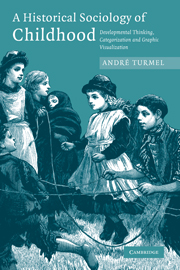 A Historical Sociology of Childhood
A Historical Sociology of Childhood Book contents
- Frontmatter
- Contents
- List of illustrations
- Acknowledgements
- Introduction
- 1 Children in the collective
- 2 Graphs, charts and tabulations: the textual inscription of children
- 3 Social technologies: regulation and resistance
- 4 The normal child: translation and circulation
- 5 Developmental thinking as a cognitive form
- Conclusion
- Appendix
- Bibliography
- Index
3 - Social technologies: regulation and resistance
Published online by Cambridge University Press: 22 September 2009
- Frontmatter
- Contents
- List of illustrations
- Acknowledgements
- Introduction
- 1 Children in the collective
- 2 Graphs, charts and tabulations: the textual inscription of children
- 3 Social technologies: regulation and resistance
- 4 The normal child: translation and circulation
- 5 Developmental thinking as a cognitive form
- Conclusion
- Appendix
- Bibliography
- Index
Summary
A child becomes an object of knowledge when it is identified as such, different from other social actors, and as methods of observation and then of recording, are discovered or implemented. These methods rest on two prerequisites: measurement and classification. One cannot conceive of recording, especially in its scientific rather than its diary form, without the practice of measurement in compliance with specific predefined parameters: the height–weight–age tables symbolize the exercise of measurement put into place. Accordingly, measurement of children in conformity with discrete parameters takes place within a system of categories: the activity of classifying children is fundamental in this respect.
The classification, enumeration and collection of data concerning children are activities by no means without consequences. On the contrary, classification directly affects the children being classified: this is regulation. And vice versa: this is resistance. ‘In medicine, the authorities who know, the doctors, tend to dominate the known about, the patients. The known about come to behave in the ways that the knower expect them to. But not always. Sometimes the known take matters into their own hands’ (Hacking 1995: 38). In between the two stands an apparatus in charge of monitoring children’s behaviour. Children are monitored through specific forms, the social technologies, considered a by-product of scientific investigation, both of the recording methods and of the activity of classification.
This chapter examines the social forms – the technologies – which contributed to social change throughout the process of delineation of a national population in a given society.
- Type
- Chapter
- Information
- A Historical Sociology of ChildhoodDevelopmental Thinking, Categorization and Graphic Visualization, pp. 115 - 181Publisher: Cambridge University PressPrint publication year: 2008


